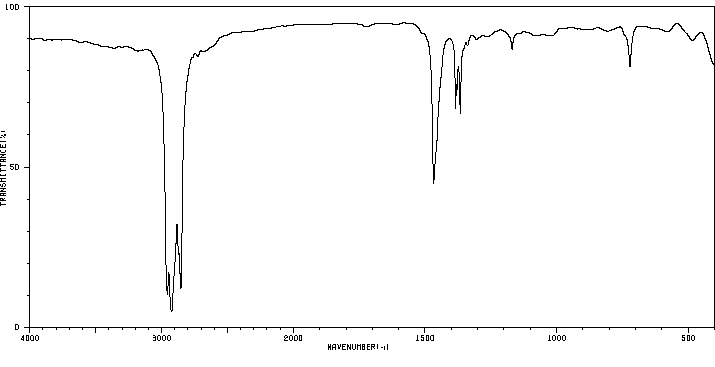C12-14异链烷烃 | 1560-97-0
中文名称
C12-14异链烷烃
中文别名
2-甲基十二烷
英文名称
isotridecane
英文别名
2-methyldodecane
CAS
1560-97-0;68551-19-9
化学式
C13H28
mdl
MFCD00060926
分子量
184.365
InChiKey
HGEMCUOAMCILCP-UHFFFAOYSA-N
BEILSTEIN
——
EINECS
——
-
物化性质
-
计算性质
-
ADMET
-
安全信息
-
SDS
-
制备方法与用途
-
上下游信息
-
文献信息
-
表征谱图
-
同类化合物
-
相关功能分类
-
相关结构分类
物化性质
-
熔点:-26°C
-
沸点:229.5°C
-
密度:0.7498
-
LogP:7.175 (est)
-
物理描述:Liquid
-
保留指数:1265;1265;1265.4;1264
计算性质
-
辛醇/水分配系数(LogP):7
-
重原子数:13
-
可旋转键数:9
-
环数:0.0
-
sp3杂化的碳原子比例:1.0
-
拓扑面积:0
-
氢给体数:0
-
氢受体数:0
SDS
反应信息
-
作为产物:描述:在 二苯基硅烷 作用下, 反应 15.0h, 以88%的产率得到C12-14异链烷烃参考文献:名称:通过三氟乙酸酯对叔醇进行自由基脱氧摘要:叔醇的三氟乙酸盐在(t BuO)2的存在下通过Ph 2 SiH 2进行脱氧,脱氧产物的收率极高,而不会影响β-碳的立体化学。DOI:10.1016/j.tetlet.2004.02.109
文献信息
-
Scope and Utility of a New Soluble Copper Catalyst [CuBr−LiSPh−LiBr−THF]: A Comparison with Other Copper Catalysts in Their Ability to Couple One Equivalent of a Grignard Reagent with an Alkyl Sulfonate作者:Dennis H. Burns、Jeffrey D. Miller、Ho-Kit Chan、Michael O. DelaneyDOI:10.1021/ja963944q日期:1997.3.1THF at 0 °C furnished a new soluble copper catalyst that was highly efficient at coupling primary, secondary, tertiary, aryl, vinyl, and allylic Grignard reagents to primary tosylates and primary Grignard reagents to secondary tosylates and mesylates, all with the use of only 1 equiv of Grignard reagent. The new catalyst was shown to be much more reactive than copper catalysts CuBr and Li2CuCl4 and more等量的 CuBr−SMe2、LiBr 和 LiSPh 在 0°C 的 THF 中的混合物提供了一种新的可溶性铜催化剂,该催化剂在将伯、仲、叔、芳基、乙烯基和烯丙基格氏试剂与伯甲苯磺酸盐和主要格氏试剂到二级甲苯磺酸盐和甲磺酸盐,所有这些都只使用 1 当量的格氏试剂。新催化剂被证明比铜催化剂 CuBr 和 Li2CuCl4 更具反应性,并且在转移仲和叔烷基方面比低级铜酸盐(吉尔曼试剂)更有效,并且表现出比低级铜酸盐更高的反应性及其偶联能力初级格氏试剂到次级磺酸盐。格氏试剂/催化剂系统与酯官能化甲苯磺酸酯相容,因此证明比没有催化剂的格氏试剂更具化学选择性。该催化剂在室温以下表现出良好的反应活性,并且在催化剂溶液中加入6% v/v的HMPA...
-
Cobalt‐Catalyzed Cross‐Coupling Reaction between Functionalized Primary and Secondary Alkyl Halides and Aliphatic Grignard Reagents作者:Gérard Cahiez、Christophe Chaboche、Christophe Duplais、Arianna Giulliani、Alban MoyeuxDOI:10.1002/adsc.200800166日期:2008.7.7The coupling of primary and secondary unactivated alkyl bromides with alkyl-Grignard reagents was performed in good yields under mild conditions by using a new catalytic system: consisting of cobalt chloride and tetramethylethylenediamine (CoCl2⋅2 LiI, 4 TMEDA). The reaction is very chemoselective since ketone, ester and nitrile functions are tolerated.
-
Copper-catalyzed cross-coupling of alkylsamarium reagents with alkyl halides作者:William F. Berkowitz、Yanzhong WuDOI:10.1016/s0040-4039(97)00604-7日期:1997.5SmI2/HMPA converts alkyl iodides and bromides to alkyl samarium reagents which can be cross-coupled with primary alkyl iodides and bromides and secondary iodides in the presence of Cu(I) halides or Li2CuCl4 at room temperature. The alkylation of primary iodides gives good yields of cross-coupling products with negligible homo-coupling products. The method is especially useful for the small scale cross-coupling
-
Copper-Catalyzed Alkyl–Alkyl Cross-Coupling Reactions Using Hydrocarbon Additives: Efficiency of Catalyst and Roles of Additives作者:Takanori Iwasaki、Reiko Imanishi、Ryohei Shimizu、Hitoshi Kuniyasu、Jun Terao、Nobuaki KambeDOI:10.1021/jo501006u日期:2014.9.19Cross-coupling of alkyl halides with alkyl Grignard reagents proceeds with extremely high TONs of up to 1230000 using a Cu/unsaturated hydrocarbon catalytic system. Alkyl fluorides, chlorides, bromides, and tosylates are all suitable electrophiles, and a TOF as high as 31200 h–1 was attained using an alkyl iodide. Side reactions of this catalytic system, i.e., reduction, dehydrohalogenation (elimination)使用铜/不饱和烃催化系统,烷基卤化物与烷基格氏试剂的交叉偶联可产生高达1230000的极高TON。烷基氟化物,氯化物,溴化物和甲苯磺酸盐都是合适的亲电子试剂,TOF高达31200 h –1使用烷基碘可以达到目的。在没有添加剂的情况下,该催化体系的副反应即还原,脱卤化氢(消除)和卤代烷的均偶联。看来该反应涉及烷基铜中间体的β-氢消除,从而产生烯烃和Cu-H物种,并且该过程既触发副反应又触发Cu催化剂的降解。形成的Cu–H可能促进歧化反应,从而促进烷基卤化物的还原,从而生成烷烃和Cu–X或Cu(0)的生成,这种歧化可以氧化添加到烷基卤化物中以产生烯烃,在某些情况下还可以是均偶联产物。1,3-丁二烯和苯丙炔等不饱和烃类添加剂通过抑制β-氢的消除在实现高效交叉偶联中起着重要作用,
-
Azo anions in synthesis. Use of trityl- and diphenyl-4-pyridylmethyl-hydrazones for reductive C–C bond formation from aldehydes and ketones作者:Jack E. Baldwin、Jeffrey C. Bottaro、Jayant N. Kolhe、Robert M. AdlingtonDOI:10.1039/c39840000022日期:——The lithium salts for trityl- and diphenyl-4-pyridylmethyl-hydrazones of both aldehydes and ketones react with electrophiles (alkyl haldies, aldehydes, and ketones) at low temperature to form C-trapped azo compounds; these intermediates decompose homolytically with loss of nitrogen below room temperature and can be diverted in a synthetically useful way to alkanes, or alkenes, or alcohols.
表征谱图
-
氢谱1HNMR
-
质谱MS
-
碳谱13CNMR
-
红外IR
-
拉曼Raman
-
峰位数据
-
峰位匹配
-
表征信息
同类化合物
顺式-1-乙基-3-甲基环己烷
顺式-1-乙基-2-甲基环丙烷
顺式-1,3-二甲基环庚烷
顺式-1,2-二甲基环丙烷
顺式-1,2-二乙基环戊烷
顺式-1,2-二(1-甲基乙基)环丙烷
顺式-1,2-二(1-甲基乙基)环丙烷
顺式,反式,反式-1,2,4-三甲基环己烷
Copper, ethyl-
辛烷-d18
辛基环戊烷
辛基环丙烷
联苯肼酯
联环戊基
羰基双(环茂二烯基)钛
矿油精
癸烷,2,8-二甲基-
癸烷
decyl radical
癸基环戊烷
異十八烷
甲烷-d3
甲烷-d2
甲烷-d1
甲烷-D4
甲烷-3H
甲烷-13C,d4
甲烷-13C
甲烷
甲基自由基
甲基环辛烷
甲基环癸烷
甲基环戊烷
甲基环己烷-Me-d3
甲基环己烷
甲基环十一烷
甲基环丙烷
甲基环丁烷.
甲基丙烷-2-d
环辛烷-D16
环辛烷
环癸烷
环戊烷-D9
环戊烷-D10
环戊烷-13C1
环戊烷,三(2-辛基十二基)-
环戊烷
环戊基甲基自由基
环戊基环庚烷
环戊基环己烷








